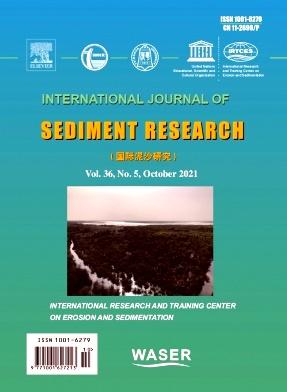四种类型的生物炭对易受细沟侵蚀的山坡土壤性质的改善和减少土壤分离的效率
IF 3.5
2区 环境科学与生态学
Q2 ENVIRONMENTAL SCIENCES
引用次数: 0
摘要
生物炭作为一种可行的基质和土壤改良剂,有可能改善土壤的物理和化学性质,从而影响土壤侵蚀。然而,很少有研究探讨了不同类型的生物炭对毁林地区坡面流侵蚀过程中土壤脱落速率的影响。为了填补这一知识空白,本研究评估了从伊朗北部森林砍伐的山坡上收集的四种不同生物炭(木材、大米、橄榄和杏仁壳)修正的土壤样品的土壤剥离能力(Dc)和细沟可蚀性(Kr)。在三层斜坡(8.5%、16.9%和25.4%)和五种流量(0.21、0.32、0.43、0.55和0.63 L/(m·s))下,通过水力水槽测量Dc。此外,还测定了改良土壤和对照土壤的主要性质,包括有机质(OM)、团聚体稳定性(MWD)、容重(BD)和阳离子交换容量(CEC)。与对照处理相比,四种生物炭的施用效果显著(p <;0.01)降低Dc(至少降低41%)。杏仁壳和稻米生物炭的施用显著提高了有机质和MWD,从而有效降低了Dc(与木材生物炭相比为- 76%)和橄榄生物炭相比为- 47%)。相关分析显示,OM、MWD、BD与Dc之间存在显著相关性。总体而言,通过主成分分析,杏仁壳和水稻生物炭处理的土壤可以与其他土壤区分为不同的类群。采用Dc与剪应力之间的线性关系来反映因变量与自变量之间的关系(决定系数R2 >;0.71)。从OM、MWD和BD数据估计Dc的多元回归方程也很准确(R2 >;0.83)。本研究表明,杏仁壳和水稻生物炭可以有效地控制和降低森林砍伐和陡峭山坡上的Dc和Kr。这项研究的发现可以帮助土地管理者选择最有效的有机基质来保持土壤,也可以帮助水文学家对陡峭山坡上的细沟侵蚀进行估计。本文章由计算机程序翻译,如有差异,请以英文原文为准。
Efficiency of four types of biochar to improve soil properties and decrease soil detachment in vulnerable hillslopes to rill erosion
Biochar, as a viable substrate and soil amendment, has the potential to improve the physical and chemical properties of soils, consequently affecting soil erosion. However, few studies have explored the impacts of different types of biochar on soil detachment rates in the hillslope rill erosion process due to overland flow in deforested areas. To fill this knowledge gap, this study evaluated the soil detachment capacity (Dc) and rill erodibility (Kr) of soil samples amended with four different biochars (wood, rice, olive, and almond shells) collected from deforested hillslopes in northern Iran. Dc was measured via a hydraulic flume at three-bed slopes (8.5%, 16.9%, and 25.4%) and five flow discharges (0.21, 0.32, 0.43, 0.55, and 0.63 L/(m·s)). Moreover, key properties of the amended soils and the control soil, including organic matter (OM), aggregate stability (MWD), bulk density (BD), and cation exchange capacity (CEC), were measured. Compared with the control treatment, the application of the four types of biochar significantly (p < 0.01) decreased the Dc (with at least a 41% reduction). The application of almond shell and rice biochars significantly increased the OM and MWD, thus effectively decreasing Dc (−76% compared with that of wood biochar) and (−47% compared with that of olive biochar). The correlation analysis revealed significant associations between OM, MWD, and BD on the one hand and Dc on the other hand. Overall, the soils treated with almond shell and rice biochars could be distinguished from the other soils into distinct groups via principal component analysis. The linear relationship between Dc and shear stress was used to reflect the relationship between the dependent and independent variables (coefficient of determination, R2 > 0.71). The multiple regression equation developed to estimate Dc from the OM, MWD, and BD data was also accurate (R2 > 0.83). This study demonstrated that almond shells and rice biochars can be effective factors in controlling and reducing Dc and Kr on deforested and steep hillslopes. The findings of this study can help land managers select the most effective organic substrate for soil conservation purposes as well as hydrologists to support the estimation of rill erosion on steep hillslopes.
求助全文
通过发布文献求助,成功后即可免费获取论文全文。
去求助
来源期刊
CiteScore
6.90
自引率
5.60%
发文量
88
审稿时长
74 days
期刊介绍:
International Journal of Sediment Research, the Official Journal of The International Research and Training Center on Erosion and Sedimentation and The World Association for Sedimentation and Erosion Research, publishes scientific and technical papers on all aspects of erosion and sedimentation interpreted in its widest sense.
The subject matter is to include not only the mechanics of sediment transport and fluvial processes, but also what is related to geography, geomorphology, soil erosion, watershed management, sedimentology, environmental and ecological impacts of sedimentation, social and economical effects of sedimentation and its assessment, etc. Special attention is paid to engineering problems related to sedimentation and erosion.

 求助内容:
求助内容: 应助结果提醒方式:
应助结果提醒方式:


